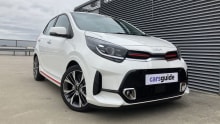
How much does it cost to replace a windscreen?
This used to be a simple question since most car windscreens were made from the...
Browse over 9,000 car reviews

When is the best time to buy a car? Well, in crazy, shook-up 2022, it depends somewhat on whether you’re buying new or used, but it’s also true that the old rules on this subject have changed lately.
The best time of year to buy a car now has more to do with supply and logistics than it once did, meaning the old rules don’t apply as strictly as they once did.
So let’s start with showroom-fresh: When is the best time to buy a new car? It was once urban lore that the best time to buy a brand-new car was early in the new year when cars with last year’s compliance plate were being cleared from showrooms. And while that’s still an important consideration, it’s by no means the only one in these volatile, supply-restricted times.
Similarly, the best time to buy a used-car was when the new model was imminent. Except that’s been turned on its head recently. Yes, it’s a brave new car-buying world out there. So what’s the reality in 2022?
Buying new

The first few weeks of a new year are still good times to buy a new car, as dealers become more and more desperate to clear the decks of cars with the previous year’s date on their compliance plate. So you might save some money by helping with that process.
The catch is that when second-hand cars are valued as trade-ins or by insurance companies, their date of manufacturer (not when they were first registered) is the defining factor.
So, suddenly, the car with the 2021 compliance plate you bought in January 2022 is already a year old. And there goes the value of any discount. If you plan to keep the car for several years, this won’t matter. But if you’re trading it in after, say, three years, you’ll take a bigger depreciation hit.

This relatively new phenomenon comes late in the year and, predictably, has been jumped on by people selling everything from stationery to puppies. And, of course, cars.
Whether or not you’ll get a deal has vastly more to do with the supply of stock and waiting lists from brand to brand, than anything to do with chaotic retail scenes in Philadelphia in the 1960s (the origin of the black Friday reference).
Boxing Day car sales were also once a reasonably big deal, but buyers don’t seem to be taking the bait to the same extent these days. Many people would rather go to the cricket than haggle with a car-dealer over their Christmas break, it seems.

There’s a temptation to think that the retail world stops on June 30 and restarts afresh on July 1 with the new financial year. Which makes no sense to anybody who’s actually in business.
But the idea of a new beginning is enough to suggest car dealers need to clear their stocks on the last day of the financial year or risk who knows what fate.
What’s more relevant is that buyers can pick up a car before June 30 and have some tax-deductable costs included on their tax return for that year, rather than waiting to claim it next tax return.
In these days of quarterly tax reporting, that’s probably less relevant than it once was. But keep an eye out for news that the government is allowing a full asset write-off on new company investments (including work vehicles) as that can send business shoppers to dealerships in a flock.
End of financial year sales are worth investigating, though, especially if dealers are willing to negotiate under the EOFYS banner in the showroom.

The arrival of a new or facelifted model in showrooms is often your cue to pick up the old model at a bargain price. But in these times of supply-chain restraints where the waiting list for many makes and models right now is out to several months, that’s less likely than before. Dealers are less keen on negotiating when they know they can sell – or have orders for – every car they can get their hands on.
Let’s not forget, either, there are cars like the Toyota LandCruiser where demand for the old V8-powered version went crazy once news broke that the new model would be V6-powered.
Throw in the supply restrictions, the fact that second-hand examples were changing hands for thousands over the new price, and you can see why nobody was getting a deal on a 200-Series LandCruiser in the run-up to the 300-Series.

Given that the rules for new cars have been shaken up, what’s the best time to buy a used car in Australia? If you’re looking for a cheap used car, then there are practically no rules we can steer you with.
You need to keep an eye on the online classifieds and grab what you want when it becomes available. That said, plenty of private sellers feel the need to ditch cars they aren’t using around tax time, but that’s a pretty vague concept. Either way, second-hand car prices have never been higher, so getting in when you can might just be the best advice.
When shopping with second-hand dealers, things are a little different. A much-anticipated new model (like the 300-Series LandCruiser) will often see a rash of trade-ins of the old model as the new one hits showrooms.
Even though there’s a huge waiting list for the 300-Series, it’s a good example as many LandCruiser owners are cashed-up and will simply trade up to the next model as a matter of habit.
Watch out, too, for new models such as a Toyota Camry, Subaru XV or Kia Cerato as they hit the market, as plenty of ride-share drivers will be trading up to the new model at that point, flooding the market with the previous model. The same goes for big rental fleets which can often choose to replace a big chunk of its fleet in one hit.
It sounds a bit mercenary, but the aftermath of natural disasters such as hail-storms can throw up plenty of cars with damage at very cheap prices as insurance companies and uninsured owners quit them.
Don’t be tempted by a flood-damaged car, however (unless you need a parts car) as these are pretty much routinely written-off by insurance companies who won’t touch that car again when you get it back on the road (if, indeed, it’s not already deemed an unrepairable write-off). Flooding causes long-term damage than insurers know will come back to bite them in years to come.
The emergence of the online auction has seen the entire car auction scene change also. But one thing hasn’t changed; unless you know intimately the make and model you’re dealing with, auctions can be a trap for young players.
You need not only to be confident that you know what to expect, but also be comfortable bidding on a car you haven’t driven and perhaps haven’t even seen in the flesh. But the emergence of the online auction site has definitely changed the time signature of these events, and rather than the odd auction every few months, there’s now a constant stream of bidding and buying going on.










Comments